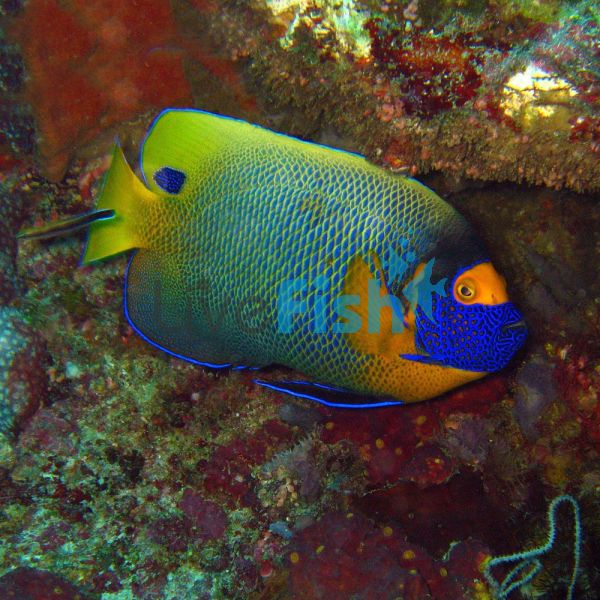Adult Blue-Faced Angelfish - Medium
The adult Blue Faced Angelfish stands out as one of the most attractive Angelfish. Its beautiful colour patterns will brighten up any aquarium.
Adult Blue-Faced Angelfish
The adult Blue Faced Angelfish has a rich variety of colours and patterns over its body. It has blue scales that have a yellow/green trim. This creates a textured lattice pattern that looks fantastic. The pattern blends into a yellow or orange colour on the dorsal fin, which also has a dark blue dot at its rear. The chin and top half of its face, between the eyes, are orange or yellow, as well as the tailfin and pectoral fins. Whether this species has orange or yellow colouring will depend on its origin. An intricate pattern of bright blue lines covers the lower face and mouth. One of the lines traces around the eye and across its forehead. This separates the orange face and the darker blue head.
There aren't any known distinguishing sexual differences. So far, it has not been possible to breed them in captivity or raise them young. In the wild, they spawn at dusk. The courtship ritual involves the male swimming around, then above the female. She will swim towards the males and he will trigger spawning by nuzzling her belly. Once the female spawns, the male releases sperm to fertilize the eggs.
Tank Recommendations for the Bluefaced Angelfish
Adult Blue Faced Angelfish need a tank that is at least 220 gallons (833 liters) capacity. This should be increased to at least 250 gallons (946 liters) if housing with other Angelfish.
A suitable tank should have plenty of rockwork for the Blue-Faced Angelfish to graze on. Rocks should be organized so that they also offer places for them to hide.
There needs to be enough open space for them to swim freely. They can cope with strong water movement, but slow movement is preferable.
The Blue Faced Angelfish is native to the Indo-Pacific region. It's found around Micronesia, the Yaeyama Islands, Vanuatu, Sumatra, Indonesia, and the Maldives. Their natural environment is in lagoons and outer reefs with an abundance of coral. Usually between depths of 5-45 meters.
Suitable Tank Buddies
The Blue-Faced Angelfish is semi-aggressive. It is one of the less aggressive Angelfish but cannot be kept with its own species. Smaller Angelfish may suffer from harassment or bullying from it.
Co-habiting with more aggressive Angelfish may cause them to deteriorate and starve. A stressful environment can trigger disease and sickness.
Usually Compatible
Bluefaced Angelfish can co-habit with small peaceful fish if the tank is large enough. Suitable companions include Dartfish, Fairy Wrasse, Assessors, and Gobies.
Sometime Compatible
If attempting to house a mated pair, the tank should be at least 250 gallons (946 liters). Clownfish, Anthias, and Dwarf Angels are okay with adult Blue Angelfish. However, juveniles may harass these fish and similar semi-aggressive species. Some larger predators may need monitoring, as slower Sharks or Rays may be harmed.
Rarely Compatible
Slow swimmers and feeders, such as Seahorses & Pipefish will be outcompeted for food. LPS corals, Sea Fans, Gorgonians, Clams, and Oysters are all at risk from Blue Faced Angelfish.
Feeding Your Bluefaced Angelfish
The Blue-Faced Angelfish is omnivorous. In the wild, it feeds on sponges and encrusting animals. In captivity, it needs a varied diet of meat and vegetable products. This can be offered as a selection of live, frozen, and prepared foods. Use meaty products such as shrimp, scallops, and chopped squid. The marine sponge can be found in certain prepared foods. Vegetables such as spinach, spirulina, and marine algae, form a large part of its diet. This fish needs to be fed at least 3 times per day.
| Scientific Name | Pomacanthus xanthometopon |
|---|---|
| Care Level | Moderate |
| Common Names | Bluefaced Angelfish, Yellowfaced Angelfish or Yellow Mask Angelfish |
| Diet | Omnivore |
| Fish Family | Pomacanthidae |
| Lifespan (years) | 21 |
| Max. Length (cm) | 38 |
| Min. Tank Volume (l) | 833 |
| Origin | Indo-Pacific region, Micronesia, the Yaeyama Islands, Vanuatu, Sumatra, Indonesia, the Maldives Size: 15 inches (38 centimeters). |
| Reef Safe | With Caution |
| Sociability | Semi-aggressive |
| Venomous | No |
| Water Conditions | 22-27.8° C (72-82° F), dKH 8-12, pH 8.1-8.4, sg 1.023-1.025 |




